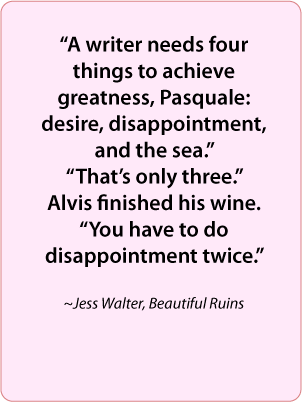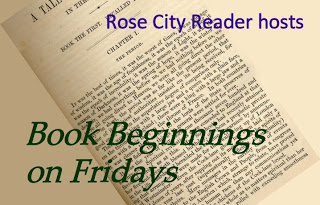Beautiful Ruins by Jess Walter is next up on our 100 Bestsellers List reading challenge. This was author Jess Walter’s sixth novel and it received much critical acclaim. NPR’s Fresh Air podcast named it the best book of 2012. Readers on Amazon and Goodreads almost universally love it. And yet, five days after I finished reading it, I remain ambivalent. There was a lot to like with this book, but equally as much not to like.
This post does not contain spoilers.
Beautiful Ruins* by Jess Walker
(*Amazon Affiliate link)
Historical Romance or Literary Fiction
Beautiful Ruins is labeled Historical Romance and also Literary Fiction, but it’s definitely not your typical bodice ripping, hero saves the day historical romance. In fact, so very little romance actually occurs that it’s difficult to see why it would be labeled as such. The only truly romantic character was Pasquale, whom we meet in the opening scene:
She smiles at him and Pasquale falls in love, and “would remain in love for the rest of his life — not so much with the woman, whom he didn’t even know, but with the moment.”
While Pasquale remains in love his whole life with the memory of Dee Moray, the movie star who appears in his small village in Italy, he goes on to experience love and a full life with another woman. The memory of Dee Moray haunts him, though, and at the end of his life he endeavors to find her and to learn what happened to her and her child.
For all of Pasquale’s romanticism, Beautiful Ruins is a study of relationships and the never-ending quest and need for love, whether from a parent/child, a lover/spouse, or friends.
Beautiful Mess
Beautiful Ruins took 15 years to write and, at 372 pages, it felt like it took that long to read. The story jumps back and forth between different time periods and locations — Italy in the 1960s, America, England and Scotland in the 1980s, present day in Hollywood and Idaho — so that you almost needed a calendar and globe to keep track.
The writing was a hodge-podge of different styles; in addition to the normal chapters, also included was the script of a play, the complete first chapter of a never-to-be-finished novel, and a screenplay pitch on the infamous Donner party, among other oddities. It reminded me of one of my attempts at National Novel Writing Month (NaNoWriMo), where I needed to achieve 50,000 words by the end of the month and had run out of things to write, so I included grocery lists and Christmas letters to achieve my word count.
Surprises
There are several strong female characters in Beautiful Ruins and perhaps that is why I believed the author, Jess Walter, to be female. Or maybe it’s because historical romance authors are predominantly female. In any case, when I finished the book and began to read the “P.S. Insights, Interviews & More…” section at the end of the Kindle version of Beautiful Ruins, I was shocked to discover that “Jess” was male! I’m not sure it makes any difference, but I was truly surprised. Actually, I think it was the only surprising thing about the whole novel. The book itself seemed predictable – chaotic but unsurprising.
I was glad for the “Insights, Interviews & More…” section at the end of the book, as that led to more understanding about the Walter’s intent when writing Beautiful Ruins. For example:
I wondered if the truth we know from physics—that an object has the most stored energy in the moment right before it acts (think of a drawn bow)— was true of romance, too, if potential wasn’t, in some way, love’s most powerful form.
Jess Walter also shared:
I was reading The Art of the Novel by Milan Kundera and I came across this: “There would seem to be nothing more obvious, more tangible and palpable than the present moment. And yet it eludes us completely. All the sadness of life lies in that fact.” This, I saw, could be the ending of the book, a way of acknowledging the power of certain moments in our lives. These are the ruins of our memories, which loom in our minds like the Parthenon, even as they are decayed and weathered by time and regret. I hoped to convey the significance of such isolated moments in our lives, to show that Pasquale and Dee’s first meeting—which had kicked around in my own head since 1997— might indeed be powerful enough to drive him to find her almost fifty years later.
As grateful as I was for that section of the book, I shouldn’t have needed it. I should have gleaned at least some of his intentions from simply reading the book. The fact that I didn’t frustrates me, and I don’t think good literature should leave the reader feeling frustrated.
Related posts:
- Book-beginnings, a discussion of the first line of the novel
- Karen’s review from a reader’s perspective
- Roberta’s review from a writer’s perspective
You can also join us on social media:
- The Bestseller Code 100 Pinterest Page
- Twitter: #BestsellerCode100
- Facebook: Bestseller Code 100 Reading Group
- The full list is now posted on GoodReads
____________________________________
What are we reading next?
If you ever have questions about what we are reading next or when we’re starting the next discussion, check the 100 Book List tab in the navigation bar at the top of the blog. Links in the list go to the landing page from this blog where the discussion starts. However, this is an open-ended challenge so feel free to jump in with any of the books at any time.
The next book is number 63. The Sense of an Ending by Julian Barnes (2011) – Discussion begins April 2, 2018
Literary fiction, won the Man Booker prize








